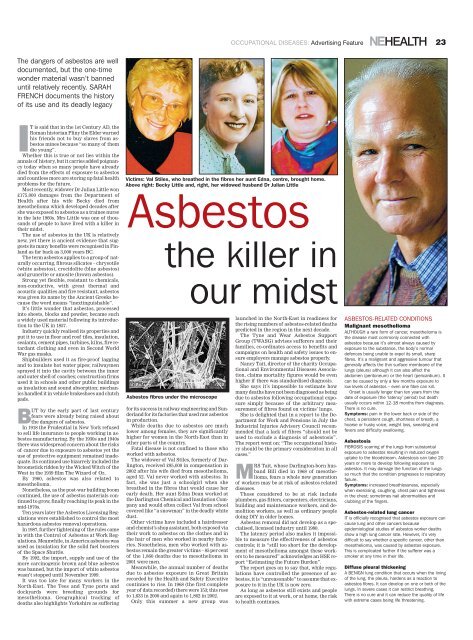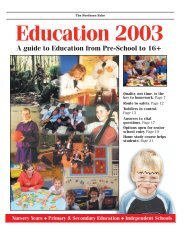SPORTS INJURY How to tackle it EXERCISE The power of Pilates ...
SPORTS INJURY How to tackle it EXERCISE The power of Pilates ...
SPORTS INJURY How to tackle it EXERCISE The power of Pilates ...
- No tags were found...
Create successful ePaper yourself
Turn your PDF publications into a flip-book with our unique Google optimized e-Paper software.
OCCUPATIONAL DISEASES: Advertising FeatureN E HEALTH23<strong>The</strong> dangers <strong>of</strong> asbes<strong>to</strong>s are welldocumented, but the one-timewonder material wasn’t banneduntil relatively recently. SARAHFRENCH documents the his<strong>to</strong>ry<strong>of</strong> <strong>it</strong>s use and <strong>it</strong>s deadly legacyIT is said that in the 1st Century AD, theRoman his<strong>to</strong>rian Pliny the Elder warnedhis friends not <strong>to</strong> buy slaves from asbes<strong>to</strong>smines because “so many <strong>of</strong> themdie young”.Whether this is true or not lies w<strong>it</strong>hin theannals <strong>of</strong> his<strong>to</strong>ry, but <strong>it</strong> carries added poignancy<strong>to</strong>day when so many people have alreadydied from the effects <strong>of</strong> exposure <strong>to</strong> asbes<strong>to</strong>sand countless more are s<strong>to</strong>ring up fatal healthproblems for the future.Most recently, widower Dr Julian L<strong>it</strong>tle won£175,000 damages from the Department <strong>of</strong>Health after his wife Becky died frommesothelioma which developed decades aftershe was exposed <strong>to</strong> asbes<strong>to</strong>s as a trainee nursein the late 1960s. Mrs L<strong>it</strong>tle was one <strong>of</strong> thousands<strong>of</strong> people <strong>to</strong> have lived w<strong>it</strong>h a killer intheir midst.<strong>The</strong> use <strong>of</strong> asbes<strong>to</strong>s in the UK is relativelynew, yet there is ancient evidence that suggests<strong>it</strong>s many benef<strong>it</strong>s were recognised in Finlandas far back as 3,000 years BC.<strong>The</strong> term asbes<strong>to</strong>s applies <strong>to</strong> a group <strong>of</strong> naturallyoccurring, fibrous silicates – chrysotile(wh<strong>it</strong>e asbes<strong>to</strong>s), crocidol<strong>it</strong>e (blue asbes<strong>to</strong>s)and gruner<strong>it</strong>e or amos<strong>it</strong>e (brown asbes<strong>to</strong>s).Strong yet flexible, resistant <strong>to</strong> chemicals,non-conductive, w<strong>it</strong>h great thermal andacoustic qual<strong>it</strong>ies and fire resistant, asbes<strong>to</strong>swas given <strong>it</strong>s name by the Ancient Greeks becausethe word means “inextinguishable”.It’s l<strong>it</strong>tle wonder that asbes<strong>to</strong>s, processedin<strong>to</strong> sheets, blocks and powder, became sucha widely used material following <strong>it</strong>s introduction<strong>to</strong> the UK in 1857.Industry quickly realised <strong>it</strong>s properties andput <strong>it</strong> <strong>to</strong> use in floor and ro<strong>of</strong> tiles, insulation,sealants, cement pipes, turbines, kilns, fire retardantclothing and even in Second WorldWar gas masks.Shipbuilders used <strong>it</strong> as fire-pro<strong>of</strong> laggingand <strong>to</strong> insulate hot water pipes; railwaymensprayed <strong>it</strong> in<strong>to</strong> the cav<strong>it</strong>y between the innerand outer shell <strong>of</strong> coaches; construction firmsused <strong>it</strong> in schools and other public buildingsas insulation and sound absorption; mechanicshandled <strong>it</strong> in vehicle brakeshoes and clutchpads.BUT by the early part <strong>of</strong> last centuryfears were already being raised aboutthe dangers <strong>of</strong> asbes<strong>to</strong>s.In 1918 the Prudential in New York refused<strong>to</strong> sell life insurance <strong>to</strong> people working in asbes<strong>to</strong>smanufacturing. By the 1930s and 1940sthere was widespread concern about the risks<strong>of</strong> cancer due <strong>to</strong> exposure <strong>to</strong> asbes<strong>to</strong>s yet theuse <strong>of</strong> protective equipment remained inadequate.Its continued use bizarrely included thebroomstick ridden by the Wicked W<strong>it</strong>ch <strong>of</strong> theWest in the 1939 film <strong>The</strong> Wizard <strong>of</strong> Oz.By 1960, asbes<strong>to</strong>s was also related <strong>to</strong>mesothelioma.Nonetheless, as the post-war building boomcontinued, the use <strong>of</strong> asbes<strong>to</strong>s materials continued<strong>to</strong> grow, finally reaching <strong>it</strong>s peak in themid-1970s.Ten years later the Asbes<strong>to</strong>s Licensing Regulationswere established <strong>to</strong> control the mosthazardous asbes<strong>to</strong>s removal operations.In 1987, further tightening <strong>of</strong> the rules camein w<strong>it</strong>h the Control <strong>of</strong> Asbes<strong>to</strong>s at Work Regulations.Meanwhile, in America asbes<strong>to</strong>s wasused as insulation for the solid fuel boosters<strong>of</strong> the Space Shuttle.By 1992, the import, supply and use <strong>of</strong> themore carcinogenic brown and blue asbes<strong>to</strong>swas banned, but the import <strong>of</strong> wh<strong>it</strong>e asbes<strong>to</strong>swasn’t s<strong>to</strong>pped until November 1999.It was <strong>to</strong>o late for many workers in theNorth-East. <strong>The</strong> Tees and Tyne ports anddockyards were breeding grounds formesothelioma. Geographical tracking <strong>of</strong>deaths also highlights Yorkshire as sufferingVictims: Val Stiles, who breathed in the fibres her aunt Edna, centre, brought home.Above right: Becky L<strong>it</strong>tle and, right, her widowed husband Dr Julian L<strong>it</strong>tleAsbes<strong>to</strong>sthe killer inour midstAsbes<strong>to</strong>s fibres under the microscopefor <strong>it</strong>s success in railway engineering and Sunderlandfor <strong>it</strong>s fac<strong>to</strong>ries that used raw asbes<strong>to</strong>sin production.While deaths due <strong>to</strong> asbes<strong>to</strong>s are muchlower among females, they are significantlyhigher for women in the North-East than inother parts <strong>of</strong> the country.Fatal disease is not confined <strong>to</strong> those whoworked w<strong>it</strong>h asbes<strong>to</strong>s.<strong>The</strong> widower <strong>of</strong> Val Stiles, formerly <strong>of</strong> Darling<strong>to</strong>n,received £95,000 in compensation in2002 after his wife died from mesothelioma,aged 52. Val never worked w<strong>it</strong>h asbes<strong>to</strong>s. Infact, she was just a schoolgirl when shebreathed in the fibres that would cause herearly death. Her aunt Edna Dean worked atthe Darling<strong>to</strong>n Chemical and Insulation Companyand would <strong>of</strong>ten collect Val from schoolcovered like “a snowman” in the deadly wh<strong>it</strong>edust.Other victims have included a hairdresserand chemist’s shop assistant, both exposed viatheir work <strong>to</strong> asbes<strong>to</strong>s on the clothes and inthe hair <strong>of</strong> men who worked in nearby fac<strong>to</strong>ries.Nonetheless, men who worked w<strong>it</strong>h asbes<strong>to</strong>sremain the greater victims – 85 per cen<strong>to</strong>f the 1,860 deaths due <strong>to</strong> mesothelioma in2001 were men.Meanwhile, the annual number <strong>of</strong> deathsdue <strong>to</strong> asbes<strong>to</strong>s exposure in Great Br<strong>it</strong>ainrecorded by the Health and Safety Executivecontinues <strong>to</strong> rise. In 1968 (the first completeyear <strong>of</strong> data recorded) there were 153; this rose<strong>to</strong> 1,633 in 2000 and again <strong>to</strong> 1,862 in 2002.Only this summer a new group waslaunched in the North-East in readiness forthe rising numbers <strong>of</strong> asbes<strong>to</strong>s-related deathspredicted in the region in the next decade.<strong>The</strong> Tyne and Wear Asbes<strong>to</strong>s SupportGroup (TWASG) advises sufferers and theirfamilies, co-ordinates access <strong>to</strong> benef<strong>it</strong>s andcampaigns on health and safety issues <strong>to</strong> ensureemployers manage asbes<strong>to</strong>s properly.Nancy Ta<strong>it</strong>, direc<strong>to</strong>r <strong>of</strong> the char<strong>it</strong>y Occupationaland Environmental Diseases Association,claims mortal<strong>it</strong>y figures would be evenhigher if there was standardised diagnosis.She says <strong>it</strong>’s impossible <strong>to</strong> estimate howmany deaths have not been diagnosed as beingdue <strong>to</strong> asbes<strong>to</strong>s following occupational exposuresimply because <strong>of</strong> the arb<strong>it</strong>rary measuremen<strong>to</strong>f fibres found on victims’ lungs.She is delighted that in a report <strong>to</strong> the Departmentfor Work and Pensions in July theIndustrial Injuries Advisory Council recommendedthat a lack <strong>of</strong> fibres “should not beused <strong>to</strong> exclude a diagnosis <strong>of</strong> asbes<strong>to</strong>sis”.<strong>The</strong> report went on: “<strong>The</strong> occupational his<strong>to</strong>ryshould be the primary consideration in allcases.”MRS Ta<strong>it</strong>, whose Darling<strong>to</strong>n-born husbandBill died in 1968 <strong>of</strong> mesothelioma,fears a whole new generation<strong>of</strong> workers may be at risk <strong>of</strong> asbes<strong>to</strong>s relateddiseases.Those considered <strong>to</strong> be at risk includeplumbers, gas f<strong>it</strong>ters, carpenters, electricians,building and maintenance workers, and demol<strong>it</strong>ionworkers, as well as ordinary peopledoing DIY in older homes.Asbes<strong>to</strong>s removal did not develop as a specialised,licensed industry until 1980.<strong>The</strong> latency period also makes <strong>it</strong> impossible<strong>to</strong> measure the effectiveness <strong>of</strong> asbes<strong>to</strong>scontrols; <strong>it</strong> is “still <strong>to</strong>o short for the developmen<strong>to</strong>f mesothelioma amongst these workers<strong>to</strong> be measured” acknowledges an HSE report“Estimating the Future Burden”.<strong>The</strong> report goes on <strong>to</strong> say that, while regulationshave controlled the presence <strong>of</strong> asbes<strong>to</strong>s,<strong>it</strong> is “unreasonable” <strong>to</strong> assume that exposure<strong>to</strong> <strong>it</strong> in the UK is now zero.As long as asbes<strong>to</strong>s still exists and peopleare exposed <strong>to</strong> <strong>it</strong> at work, or at home, the risk<strong>to</strong> health continues.ASBESTOS-RELATED CONDITIONSMalignant mesotheliomaALTHOUGH a rare form <strong>of</strong> cancer, mesothelioma isthe disease most commonly connected w<strong>it</strong>hasbes<strong>to</strong>s because <strong>it</strong>’s almost always caused byexposure <strong>to</strong> the substance, the body’s normaldefences being unable <strong>to</strong> expel <strong>it</strong>s small, sharpfibres. It’s a malignant and aggressive tumour thatgenerally affects the thin surface membrane <strong>of</strong> thelungs (pleura) although <strong>it</strong> can also affect theabdomen (peri<strong>to</strong>neum) or the heart (pericardium). Itcan be caused by only a few months exposure <strong>to</strong>low levels <strong>of</strong> asbes<strong>to</strong>s – even one fibre can kill.Onset is usually longer than ten years from thedate <strong>of</strong> exposure (the ‘latency’ period) but deathusually occurs w<strong>it</strong>hin 12-18 months from diagnosis.<strong>The</strong>re is no cure.Symp<strong>to</strong>ms: pain in the lower back or side <strong>of</strong> thechest, a persistent cough, shortness <strong>of</strong> breath, ahoarse or husky voice, weight loss, sweating andfevers and difficulty swallowing.Asbes<strong>to</strong>sisFIBROSIS scarring <strong>of</strong> the lungs from substantialexposure <strong>to</strong> asbes<strong>to</strong>s resulting in reduced oxygenuptake <strong>to</strong> the bloodstream. Asbes<strong>to</strong>sis can take 20years or more <strong>to</strong> develop following exposure <strong>to</strong>asbes<strong>to</strong>s. It may damage the function <strong>of</strong> the lungsso much that the cond<strong>it</strong>ion progresses <strong>to</strong> respira<strong>to</strong>ryfailure.Symp<strong>to</strong>ms: increased breathlessness, especiallywhen exercising, coughing, chest pain and tightnessin the chest; sometimes nail abnormal<strong>it</strong>ies andclubbing <strong>of</strong> the fingers.Asbes<strong>to</strong>s-related lung cancerIT is <strong>of</strong>ficially recognised that asbes<strong>to</strong>s exposure cancause lung and other cancers becauseepidemiological studies <strong>of</strong> asbes<strong>to</strong>s worker deathsshow a high lung cancer rate. <strong>How</strong>ever, <strong>it</strong>’s verydifficult <strong>to</strong> say whether a specific cancer, other thanmesothelioma, was caused by asbes<strong>to</strong>s exposure.This is complicated further if the sufferer was asmoker at any time in their life.Diffuse pleural thickeningA BENIGN lung cond<strong>it</strong>ion that occurs when the lining<strong>of</strong> the lung, the pleura, hardens as a reaction <strong>to</strong>asbes<strong>to</strong>s fibres. It can develop on one or both <strong>of</strong> thelungs. In severe cases <strong>it</strong> can restrict breathing.<strong>The</strong>re is no cure and <strong>it</strong> can reduce the qual<strong>it</strong>y <strong>of</strong> lifew<strong>it</strong>h extreme cases being life threatening.
















